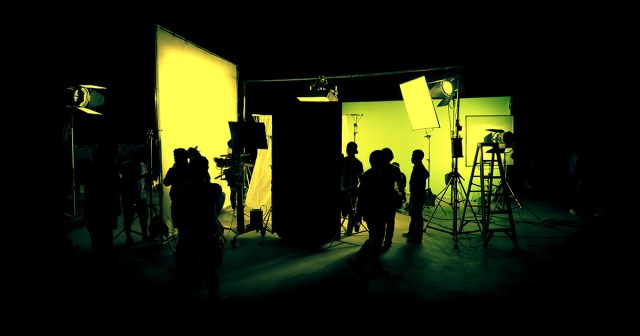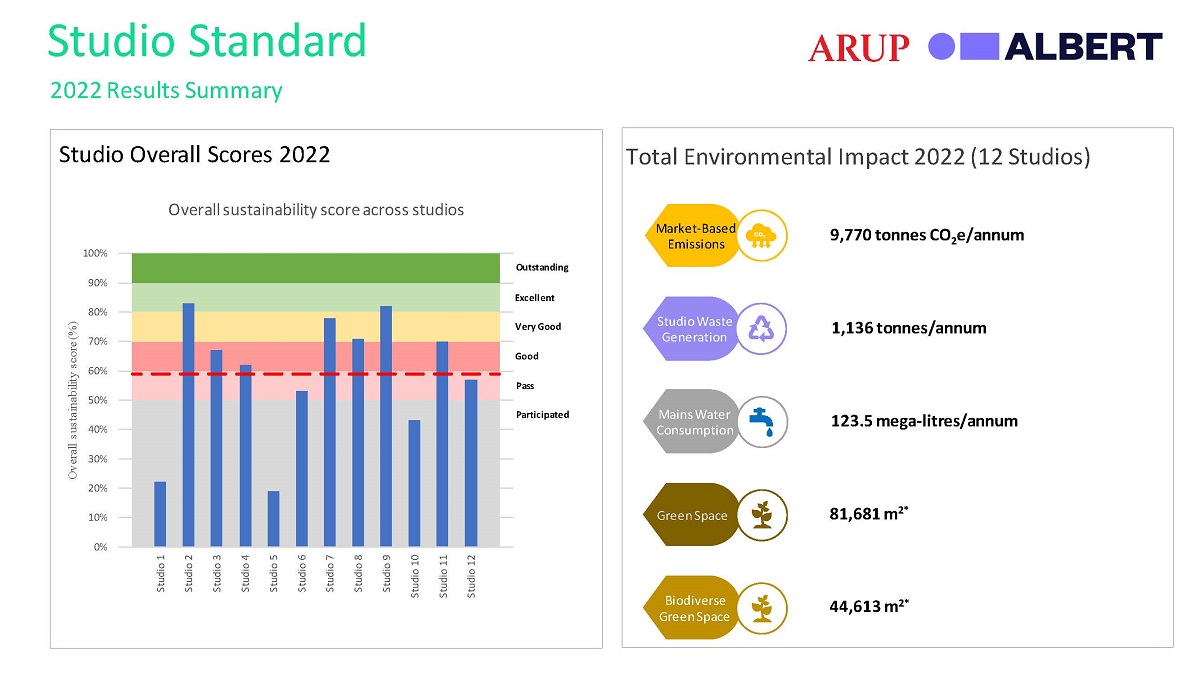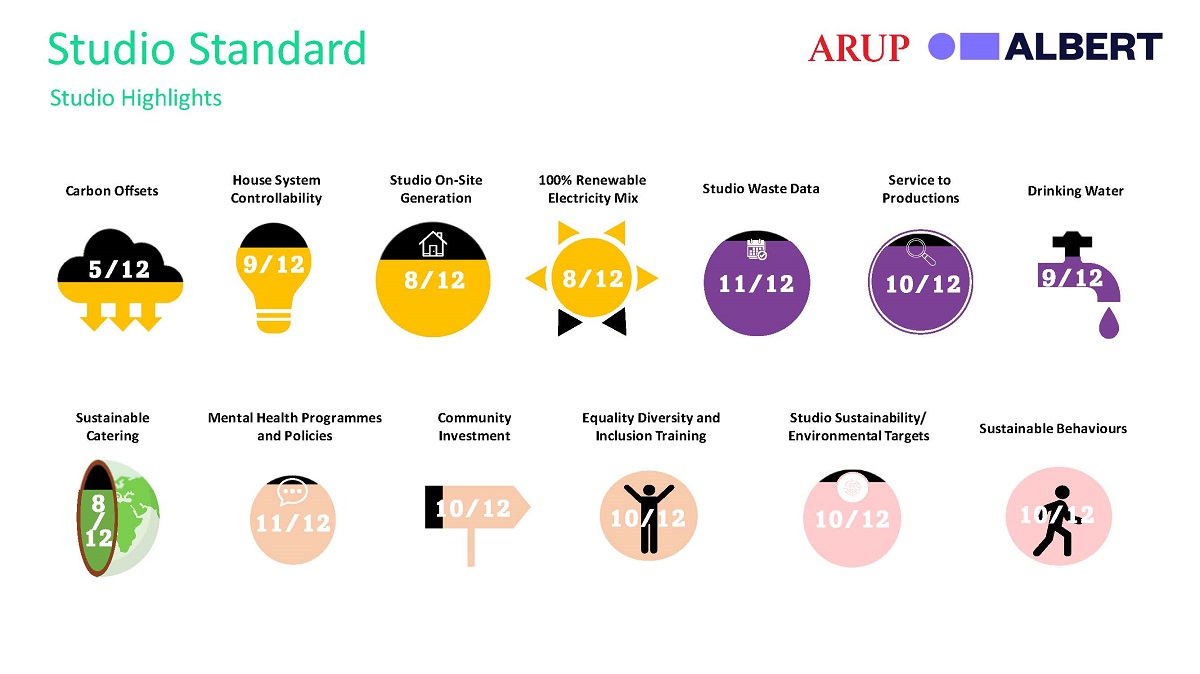
TL;DR
- Twelve studios undertook the Studio Sustainability Standard in 2022, committing to measuring carbon emissions, reducing waste, and charting a course toward zero-carbon, zero-waste facilities.
- Participating studios gain a competitive edge through bespoke performance reports and ratings, enabling benchmarking against global peers.
- Studios wanting to be involved in the 2023/24 report need to submit applications by the end of November.
READ MORE: Studio Sustainability Standard (albert)
No one should need to have the importance of sustainability explained so film and TV studios should welcome the chance to benchmark their business with the Studio Sustainability Standard.
Organized by the UK’s BAFTA through its albert scheme, this is a voluntary, global standard for studio facilities. With the first year under its belt involving 12 studios, the program is keen to enlist more studios and suggests that not doing so will be detrimental to a studio’s brand reputation.
“This commitment to sustainability builds a positive brand image, attracting environmentally conscious partners, investors who want to support sustainable productions and meeting audience demands for more sustainability on and off screen,” says albert Project Lead Steve Smith.
Research published in 2020 found that the average tentpole film production — a film with a budget of more than $70 million — generates 2,840 tons of carbon dioxide emissions.
In response, albert worked with a range of film industry stakeholders and Arup as technical partner, to develop the Standard.
It has three primary aims: to guide studios in the practical steps they can make to become more sustainable; to act as an incentive for studios to clean up their acts, encouraging studios to collect data on their own sustainability progress; and to bring that data together to create a picture of the progress of the industry as a whole.
The dozen studios that participated in the first year were all from the UK with the exception of Sony Pictures Studios in Culver City, California. Others included 3 Mills Studios, BBC Studioworks (which came out on top), Elstree Studios, Maidstone Studios, Warner Bros. Studios Leavesden, and Wolf Studios Wales.

While commending the 12 for getting involved, Smith somewhat icily notes that dozens of others have so far failed to engage.
“In a world grappling with the urgency of climate change, 12 studios have stepped up to the plate, embracing their responsibility and driving a transformative shift towards sustainable practices in a commitment to align with net-zero pathways. This report celebrates the studio trailblazers who are helping to redefine what it means to be an environmentally conscious industry.”
In this first year, five studios were awarded with the rating of “Very Good” — not the highest grade possible but that is to be expected, particularly when many older studios have legacy buildings with inefficient energy insulation.
More significant than the rating, according to albert, “is the fact that 12 leading studios committed to measuring and reducing their environmental impacts.”
As sustainability rises up the agenda, these studios will be able to use their albert certifications to gain an edge over competitors when booking business. Quite how much the sustainability of a studio facility plays into the thinking of executives when budgeting and planning to locate shows is another matter. Anecdotally, reports suggest that this depends production to production with some film and TV clients keen to show corporate and social leadership (Netflix is often cited) and others paying mere lip service.
Carys Taylor, director of BAFTA albert, says, “The Studio Sustainability Standard ratings badges allows studios to show off the progress they’ve already made and benchmark the progress yet to come. And productions will know where to go to get support for their own sustainability missions.”

This idea of competitive edge is being used as the carrot to entice more studios to join up for the second round of the report.
The performance rating of the next round is valid for 12 months from the date it is issued (April 1, 2024).
Studios failing to reach the minimum standard, will be awarded a “participated” badge for that year.
Submissions are processed by an experienced team of data analysts at albert and Arup. The standard itself will be updated every two years following input from a steering group of experienced studio facility operators, trade bodies and producers.
The cost for a studio to be involved is dependent on the square footage of its sound stages.
Among factors taken into account are electricity consumption, reliance on diesel generators, waste disposal, water efficiency and transport emissions.
The scorecard prioritizes more impactful measures including the use of LED lighting across the studio, incentivizing productions to utilize LED lighting providers and ensuring the studio has achieved 100% renewable electricity sourcing.
Credits can also be gained for on-site renewable energy generation which could include solar or wind turbines and zero plastics use.
“For studios that participated in 2022, the response was overwhelmingly positive in terms of the quality of submissions and the performance that it revealed,” Smith said.
“We hope that studios will reflect on their feedback and seek out ways to be even better in 2023. In many cases it was clear from submissions that studios are already on an improving trajectory with additional measures in the pipeline. We hope that studios will take confidence from initiatives that others have in place to make further improvements.”
Studios wanting to get involved in next round of the report need to submit before the end of November 2023.
You Might Also Be Interested In
- Sustainability in Media & Entertainment
- How Productions Can Meet the Industry’s Climate Goals
- Hollywood’s Climate Story: A New Script for Sustainability

